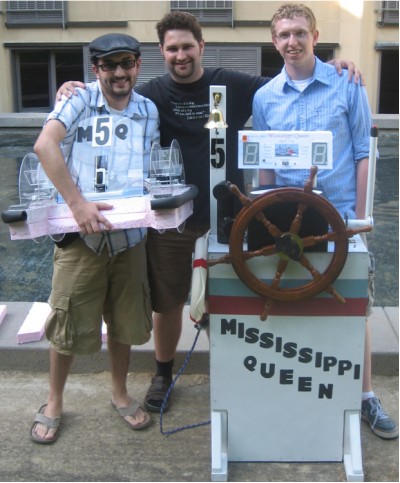Mississippi Queen is a remote-controlled robotic boat that is capable of playing a simplified game of water rugby in coordination with other robotic boats. The team created both the boat itself and the remote controller for it, using a class-standard communications protocol that enabled the controller to control any boat built in the class and the boat to be controlled by any controller built in the class.
The boat has two giant waterwheels that can be driven both forward and backward and at differential speeds from each other in order to effect forward, reverse, and rotational motion. These velocity commands are sent from the controller using a ship steering wheel for rotation and a throttle lever for forward/reverse; the boat calculates on the fly how to convert these two commands into speeds for each waterwheel. The boat also keeps track of a “crew morale”; the faster the boat is commanded to drive, the lower the crew’s morale gets. If the crew’s morale drops too low, the boat’s crew mutinies. The controller can suppress a mutiny by ringing the ship bell within two seconds of the mutiny; a microphone implanted by the bell picks up the ringing (and nothing else) and tells the boat that the mutiny has been suppressed. The controller can also jettison the crew (intentionally give up command of the boat) by picking up the life ring and throwing it overboard, and assert command over a boat if it does not already have one in its control. The user interface of the controller is augmented by two seven-segment displays, which inform the user of which boat(s) are currently available, which boat is currently under this controller’s command, and what the current morale of the controlled boat is.
Game play consists of two teams in the pond, each trying to push a beach ball into an inflatable goal before the other. Teams consist of four boats and five controllers; the fifth controller is included so that, as mutinies occur, team sizes may become unequal, making the game more interesting to watch. Mississippi Queen is designed to push the ball using the cavity cut out of its front section; in order to leave the most room for both the ball cavity and the waterwheels, the full 18” x 24” projection allowed by the project specification was employed. The full project specification, including requirements for the robots (all of which were met by Mississippi Queen) as well as the complete description of game play, can be found at here.
Mississippi Queen is the creation of Andrew Parra, David Hoffert, and Stuart Calder, all graduate students at Stanford University in Palo Alto, California, for the project portion of the course ME 218C, Spring 2009.


